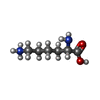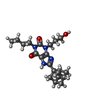[English] 日本語
 Yorodumi
Yorodumi- PDB-5n2s: Crystal structure of stabilized A1 receptor in complex with PSB36... -
+ Open data
Open data
- Basic information
Basic information
| Entry | Database: PDB / ID: 5n2s | ||||||
|---|---|---|---|---|---|---|---|
| Title | Crystal structure of stabilized A1 receptor in complex with PSB36 at 3.3A resolution | ||||||
 Components Components | Soluble cytochrome b562,Adenosine receptor A1 | ||||||
 Keywords Keywords | MEMBRANE PROTEIN / G-PROTEIN-COUPLED RECEPTOR / INTEGRAL THERMOSTABILIZING MUTATIONS | ||||||
| Function / homology |  Function and homology information Function and homology informationpositive regulation of nucleoside transport / negative regulation of neurotrophin production / negative regulation of circadian sleep/wake cycle, non-REM sleep / regulation of glomerular filtration / purine nucleoside binding / G protein-coupled purinergic nucleotide receptor signaling pathway / negative regulation of mucus secretion / positive regulation of peptide secretion / negative regulation of glutamate secretion / negative regulation of synaptic transmission, GABAergic ...positive regulation of nucleoside transport / negative regulation of neurotrophin production / negative regulation of circadian sleep/wake cycle, non-REM sleep / regulation of glomerular filtration / purine nucleoside binding / G protein-coupled purinergic nucleotide receptor signaling pathway / negative regulation of mucus secretion / positive regulation of peptide secretion / negative regulation of glutamate secretion / negative regulation of synaptic transmission, GABAergic / negative regulation of long-term synaptic depression / positive regulation of lipid catabolic process / positive regulation of dephosphorylation / negative regulation of hormone secretion / negative regulation of leukocyte migration / mucus secretion / regulation of sensory perception of pain / Adenosine P1 receptors / heterotrimeric G-protein binding / G protein-coupled adenosine receptor activity / regulation of respiratory gaseous exchange by nervous system process / response to purine-containing compound / regulation of presynaptic cytosolic calcium ion concentration / positive regulation of potassium ion transport / negative regulation of systemic arterial blood pressure / negative regulation of synaptic transmission, glutamatergic / regulation of cardiac muscle cell contraction / long-term synaptic depression / presynaptic active zone / protein targeting to membrane / triglyceride homeostasis / leukocyte migration / temperature homeostasis / detection of temperature stimulus involved in sensory perception of pain / positive regulation of systemic arterial blood pressure / negative regulation of acute inflammatory response / negative regulation of long-term synaptic potentiation / asymmetric synapse / axolemma / fatty acid homeostasis / phagocytosis / negative regulation of lipid catabolic process / lipid catabolic process / heat shock protein binding / calyx of Held / excitatory postsynaptic potential / apoptotic signaling pathway / electron transport chain / G protein-coupled receptor binding / adenylate cyclase-inhibiting G protein-coupled receptor signaling pathway / G-protein beta/gamma-subunit complex binding / cognition / vasodilation / terminal bouton / nervous system development / cell-cell signaling / presynaptic membrane / G alpha (i) signalling events / basolateral plasma membrane / dendritic spine / postsynaptic membrane / periplasmic space / response to hypoxia / electron transfer activity / positive regulation of MAPK cascade / cilium / G protein-coupled receptor signaling pathway / iron ion binding / inflammatory response / protein heterodimerization activity / negative regulation of cell population proliferation / neuronal cell body / heme binding / dendrite / synapse / negative regulation of apoptotic process / signal transduction / plasma membrane Similarity search - Function | ||||||
| Biological species |   Homo sapiens (human) Homo sapiens (human) | ||||||
| Method |  X-RAY DIFFRACTION / X-RAY DIFFRACTION /  SYNCHROTRON / SYNCHROTRON /  MOLECULAR REPLACEMENT / Resolution: 3.303 Å MOLECULAR REPLACEMENT / Resolution: 3.303 Å | ||||||
 Authors Authors | Cheng, R.K.Y. / Segala, E. / Robertson, N. / Deflorian, F. / Dore, A.S. / Errey, J.C. / Fiez-Vandal, C. / Marshall, F.H. / Cooke, R.M. | ||||||
 Citation Citation |  Journal: Structure / Year: 2017 Journal: Structure / Year: 2017Title: Structures of Human A1 and A2A Adenosine Receptors with Xanthines Reveal Determinants of Selectivity. Authors: Cheng, R.K.Y. / Segala, E. / Robertson, N. / Deflorian, F. / Dore, A.S. / Errey, J.C. / Fiez-Vandal, C. / Marshall, F.H. / Cooke, R.M. | ||||||
| History |
|
- Structure visualization
Structure visualization
| Structure viewer | Molecule:  Molmil Molmil Jmol/JSmol Jmol/JSmol |
|---|
- Downloads & links
Downloads & links
- Download
Download
| PDBx/mmCIF format |  5n2s.cif.gz 5n2s.cif.gz | 170 KB | Display |  PDBx/mmCIF format PDBx/mmCIF format |
|---|---|---|---|---|
| PDB format |  pdb5n2s.ent.gz pdb5n2s.ent.gz | 134.9 KB | Display |  PDB format PDB format |
| PDBx/mmJSON format |  5n2s.json.gz 5n2s.json.gz | Tree view |  PDBx/mmJSON format PDBx/mmJSON format | |
| Others |  Other downloads Other downloads |
-Validation report
| Summary document |  5n2s_validation.pdf.gz 5n2s_validation.pdf.gz | 697.9 KB | Display |  wwPDB validaton report wwPDB validaton report |
|---|---|---|---|---|
| Full document |  5n2s_full_validation.pdf.gz 5n2s_full_validation.pdf.gz | 701.2 KB | Display | |
| Data in XML |  5n2s_validation.xml.gz 5n2s_validation.xml.gz | 15.6 KB | Display | |
| Data in CIF |  5n2s_validation.cif.gz 5n2s_validation.cif.gz | 20.4 KB | Display | |
| Arichive directory |  https://data.pdbj.org/pub/pdb/validation_reports/n2/5n2s https://data.pdbj.org/pub/pdb/validation_reports/n2/5n2s ftp://data.pdbj.org/pub/pdb/validation_reports/n2/5n2s ftp://data.pdbj.org/pub/pdb/validation_reports/n2/5n2s | HTTPS FTP |
-Related structure data
| Related structure data |  5mzjC  5mzpC  5n2rC  5iu4S S: Starting model for refinement C: citing same article ( |
|---|---|
| Similar structure data |
- Links
Links
- Assembly
Assembly
| Deposited unit | 
| ||||||||
|---|---|---|---|---|---|---|---|---|---|
| 1 |
| ||||||||
| Unit cell |
| ||||||||
| Components on special symmetry positions |
|
- Components
Components
| #1: Protein | Mass: 48445.855 Da / Num. of mol.: 1 Mutation: A57L, T91A, N159A, Y205A, L236A, L240A, T277A, C309S,A57L, T91A, N159A, Y205A, L236A, L240A, T277A, C309S Source method: isolated from a genetically manipulated source Source: (gene. exp.)   Homo sapiens (human) Homo sapiens (human)Gene: cybC, ADORA1 / Plasmid: PFAST-BAC / Production host:  Trichoplusia ni (cabbage looper) / Strain (production host): TNI PRO / References: UniProt: P0ABE7, UniProt: P30542 Trichoplusia ni (cabbage looper) / Strain (production host): TNI PRO / References: UniProt: P0ABE7, UniProt: P30542 | ||||
|---|---|---|---|---|---|
| #2: Chemical | ChemComp-8K8 / | ||||
| #3: Chemical | | #4: Water | ChemComp-HOH / | Has protein modification | Y | |
-Experimental details
-Experiment
| Experiment | Method:  X-RAY DIFFRACTION / Number of used crystals: 1 X-RAY DIFFRACTION / Number of used crystals: 1 |
|---|
- Sample preparation
Sample preparation
| Crystal | Density Matthews: 3.72 Å3/Da / Density % sol: 66.92 % / Description: PLATES |
|---|---|
| Crystal grow | Temperature: 293 K / Method: lipidic cubic phase / pH: 7.5 Details: 0.1M SODIUM / POTASSIUM PHOSPHATE PH 7.5, 0.2M LITHIUM SULPHATE, 37.5% (W/V) PEG400 |
-Data collection
| Diffraction | Mean temperature: 100 K |
|---|---|
| Diffraction source | Source:  SYNCHROTRON / Site: SYNCHROTRON / Site:  Diamond Diamond  / Beamline: I24 / Wavelength: 0.96863 Å / Beamline: I24 / Wavelength: 0.96863 Å |
| Detector | Type: DECTRIS PILATUS 6M / Detector: PIXEL / Date: Mar 30, 2016 / Details: (DOUBLE) KB MIRROR PAIR |
| Radiation | Monochromator: DOUBLE SI(111) CRYSTAL / Protocol: SINGLE WAVELENGTH / Monochromatic (M) / Laue (L): M / Scattering type: x-ray |
| Radiation wavelength | Wavelength: 0.96863 Å / Relative weight: 1 |
| Reflection | Resolution: 3.303→160.6 Å / Num. obs: 9824 / % possible obs: 97.8 % / Redundancy: 5.1 % / CC1/2: 0.997 / Rmerge(I) obs: 0.137 / Net I/σ(I): 7.9 |
| Reflection shell | Resolution: 3.303→3.57 Å / Redundancy: 5.2 % / Rmerge(I) obs: 0.887 / Mean I/σ(I) obs: 1.6 / Num. unique obs: 1930 / CC1/2: 0.782 / % possible all: 98.6 |
- Processing
Processing
| Software |
| ||||||||||||||||||||||||||||||||||||||||||||||||||||||||||||||||||||||||||||||||||||||||||||||||||||
|---|---|---|---|---|---|---|---|---|---|---|---|---|---|---|---|---|---|---|---|---|---|---|---|---|---|---|---|---|---|---|---|---|---|---|---|---|---|---|---|---|---|---|---|---|---|---|---|---|---|---|---|---|---|---|---|---|---|---|---|---|---|---|---|---|---|---|---|---|---|---|---|---|---|---|---|---|---|---|---|---|---|---|---|---|---|---|---|---|---|---|---|---|---|---|---|---|---|---|---|---|---|
| Refinement | Method to determine structure:  MOLECULAR REPLACEMENT MOLECULAR REPLACEMENTStarting model: 5IU4 Resolution: 3.303→32.891 Å / SU ML: 0.42 / Cross valid method: FREE R-VALUE / σ(F): 1.35 / Phase error: 31.76
| ||||||||||||||||||||||||||||||||||||||||||||||||||||||||||||||||||||||||||||||||||||||||||||||||||||
| Solvent computation | Shrinkage radii: 0.9 Å / VDW probe radii: 1.11 Å | ||||||||||||||||||||||||||||||||||||||||||||||||||||||||||||||||||||||||||||||||||||||||||||||||||||
| Refinement step | Cycle: LAST / Resolution: 3.303→32.891 Å
| ||||||||||||||||||||||||||||||||||||||||||||||||||||||||||||||||||||||||||||||||||||||||||||||||||||
| Refine LS restraints |
| ||||||||||||||||||||||||||||||||||||||||||||||||||||||||||||||||||||||||||||||||||||||||||||||||||||
| LS refinement shell |
| ||||||||||||||||||||||||||||||||||||||||||||||||||||||||||||||||||||||||||||||||||||||||||||||||||||
| Refinement TLS params. | Method: refined / Refine-ID: X-RAY DIFFRACTION
| ||||||||||||||||||||||||||||||||||||||||||||||||||||||||||||||||||||||||||||||||||||||||||||||||||||
| Refinement TLS group |
|
 Movie
Movie Controller
Controller






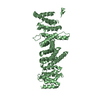



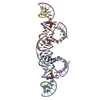
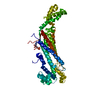
 PDBj
PDBj











